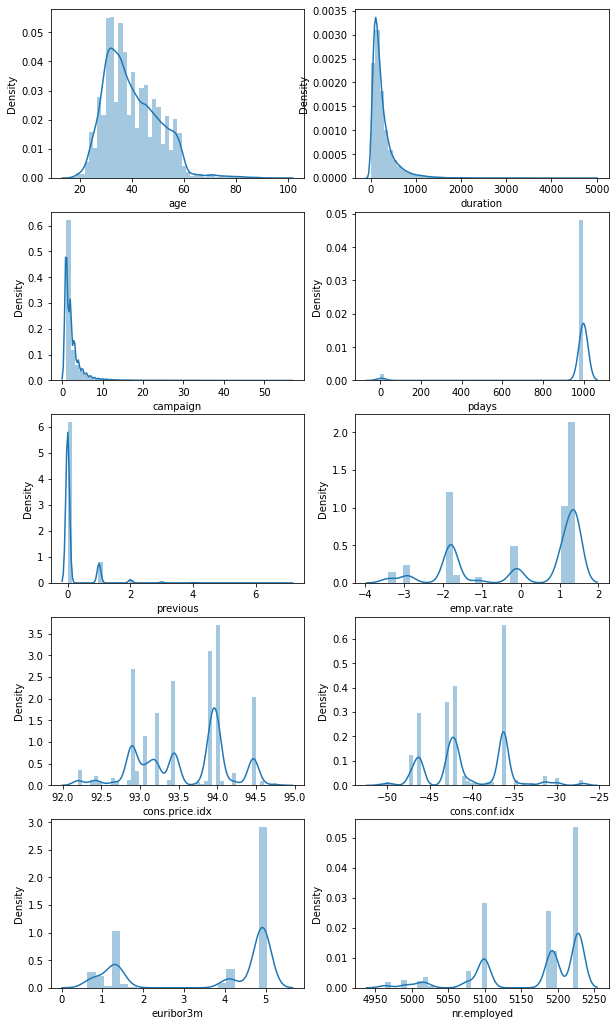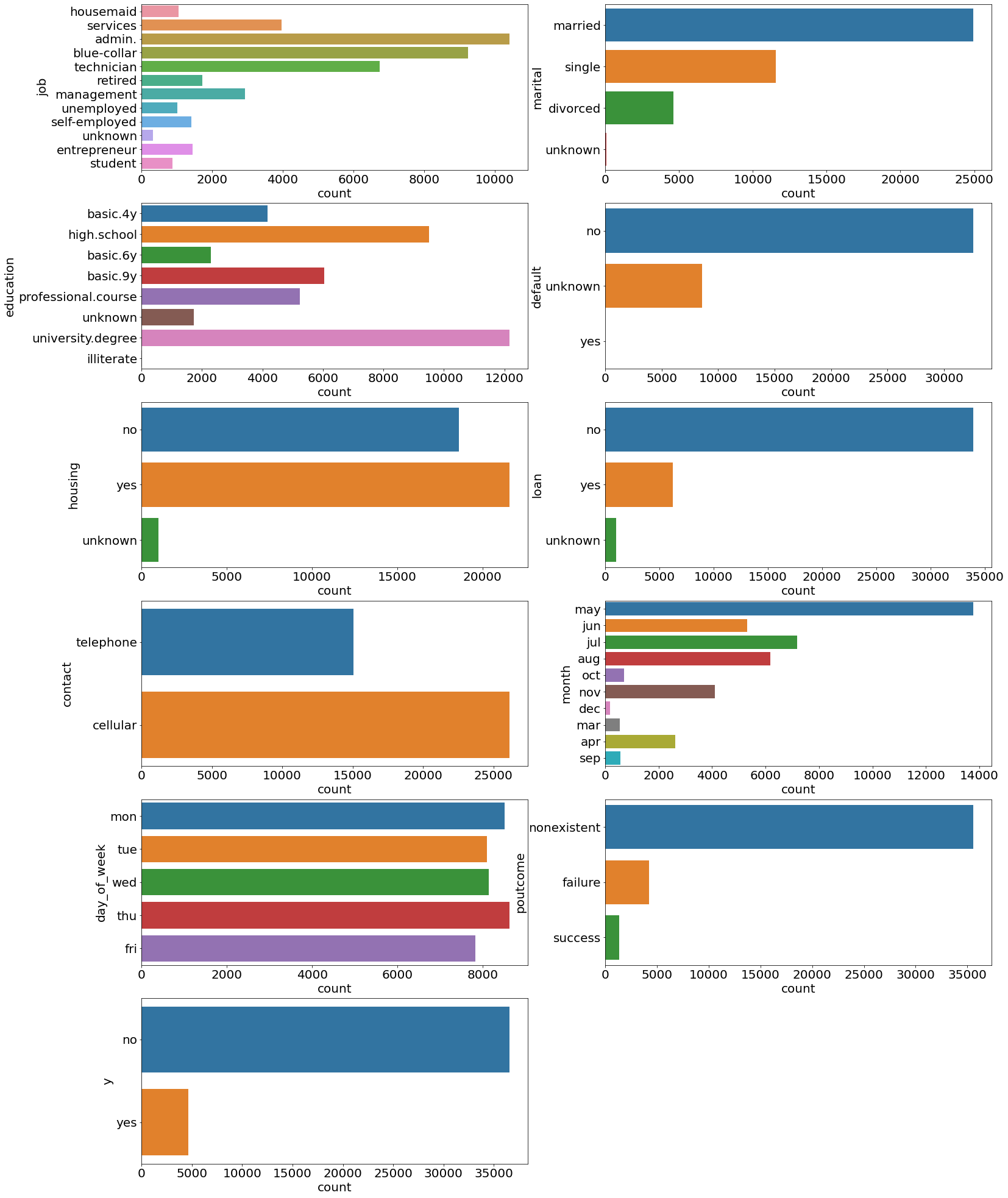Initial data analysis
Loading the data and performing some initial exploration on it to acquire some basic knowledge about the data, how the various features are distributed.
Importing libraries and packages
Loading dataset
|
0 |
1 |
2 |
3 |
4 |
| age |
56 |
57 |
37 |
40 |
56 |
| job |
housemaid |
services |
services |
admin. |
services |
| marital |
married |
married |
married |
married |
married |
| education |
basic.4y |
high.school |
high.school |
basic.6y |
high.school |
| default |
no |
unknown |
no |
no |
no |
| housing |
no |
no |
yes |
no |
no |
| loan |
no |
no |
no |
no |
yes |
| contact |
telephone |
telephone |
telephone |
telephone |
telephone |
| month |
may |
may |
may |
may |
may |
| day_of_week |
mon |
mon |
mon |
mon |
mon |
| duration |
261 |
149 |
226 |
151 |
307 |
| campaign |
1 |
1 |
1 |
1 |
1 |
| pdays |
999 |
999 |
999 |
999 |
999 |
| previous |
0 |
0 |
0 |
0 |
0 |
| poutcome |
nonexistent |
nonexistent |
nonexistent |
nonexistent |
nonexistent |
| emp.var.rate |
1.1 |
1.1 |
1.1 |
1.1 |
1.1 |
| cons.price.idx |
93.994 |
93.994 |
93.994 |
93.994 |
93.994 |
| cons.conf.idx |
-36.4 |
-36.4 |
-36.4 |
-36.4 |
-36.4 |
| euribor3m |
4.857 |
4.857 |
4.857 |
4.857 |
4.857 |
| nr.employed |
5191.0 |
5191.0 |
5191.0 |
5191.0 |
5191.0 |
| y |
no |
no |
no |
no |
no |
Exploring dataset
Data dimension: (41188, 21)
Column: age | type: int64 | missing values: 0
Column: job | type: object | missing values: 0
Column: marital | type: object | missing values: 0
Column: education | type: object | missing values: 0
Column: default | type: object | missing values: 0
Column: housing | type: object | missing values: 0
Column: loan | type: object | missing values: 0
Column: contact | type: object | missing values: 0
Column: month | type: object | missing values: 0
Column: day_of_week | type: object | missing values: 0
Column: duration | type: int64 | missing values: 0
Column: campaign | type: int64 | missing values: 0
Column: pdays | type: int64 | missing values: 0
Column: previous | type: int64 | missing values: 0
Column: poutcome | type: object | missing values: 0
Column: emp.var.rate | type: float64 | missing values: 0
Column: cons.price.idx | type: float64 | missing values: 0
Column: cons.conf.idx | type: float64 | missing values: 0
Column: euribor3m | type: float64 | missing values: 0
Column: nr.employed | type: float64 | missing values: 0
Column: y | type: object | missing values: 0
['age', 'duration', 'campaign', 'pdays', 'previous', 'emp.var.rate', 'cons.price.idx', 'cons.conf.idx', 'euribor3m', 'nr.employed']
|
count |
mean |
std |
min |
25% |
50% |
75% |
max |
| age |
41188.0 |
40.024060 |
10.421250 |
17.000 |
32.000 |
38.000 |
47.000 |
98.000 |
| duration |
41188.0 |
258.285010 |
259.279249 |
0.000 |
102.000 |
180.000 |
319.000 |
4918.000 |
| campaign |
41188.0 |
2.567593 |
2.770014 |
1.000 |
1.000 |
2.000 |
3.000 |
56.000 |
| pdays |
41188.0 |
962.475454 |
186.910907 |
0.000 |
999.000 |
999.000 |
999.000 |
999.000 |
| previous |
41188.0 |
0.172963 |
0.494901 |
0.000 |
0.000 |
0.000 |
0.000 |
7.000 |
| emp.var.rate |
41188.0 |
0.081886 |
1.570960 |
-3.400 |
-1.800 |
1.100 |
1.400 |
1.400 |
| cons.price.idx |
41188.0 |
93.575664 |
0.578840 |
92.201 |
93.075 |
93.749 |
93.994 |
94.767 |
| cons.conf.idx |
41188.0 |
-40.502600 |
4.628198 |
-50.800 |
-42.700 |
-41.800 |
-36.400 |
-26.900 |
| euribor3m |
41188.0 |
3.621291 |
1.734447 |
0.634 |
1.344 |
4.857 |
4.961 |
5.045 |
| nr.employed |
41188.0 |
5167.035911 |
72.251528 |
4963.600 |
5099.100 |
5191.000 |
5228.100 |
5228.100 |
Total number of entries:
yes 4640
no 36548
Name: y, dtype: int64
Percentages:
yes 11.265417
no 88.734583
Name: y, dtype: float64



